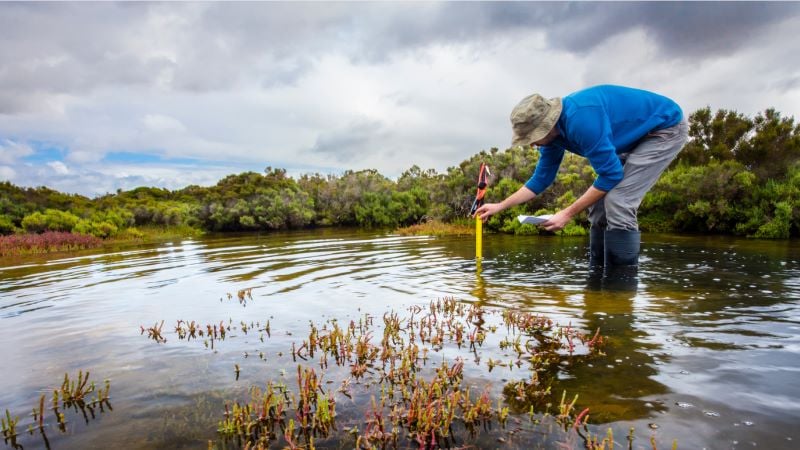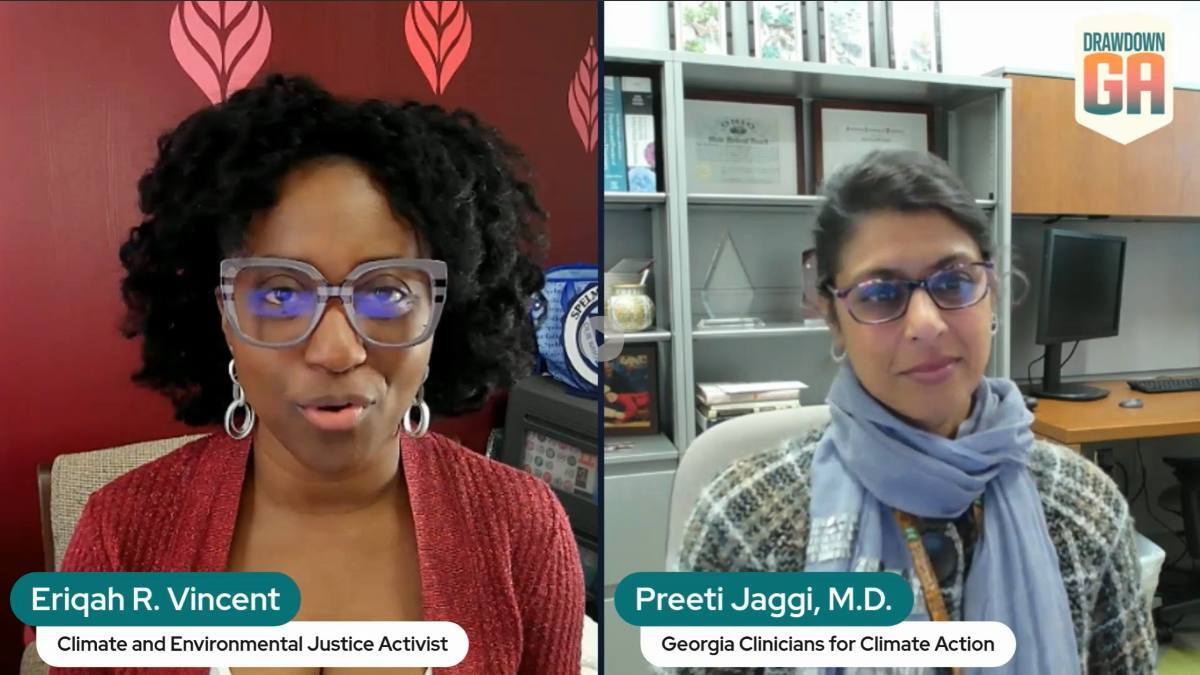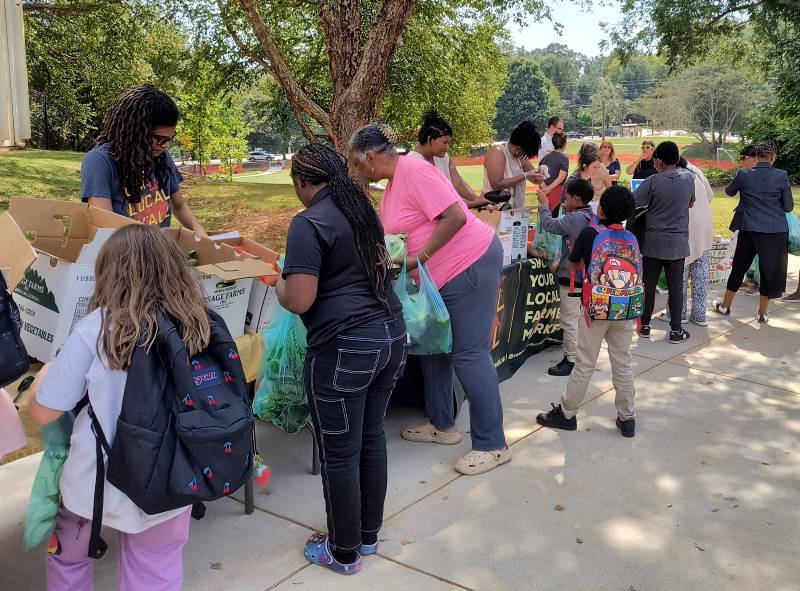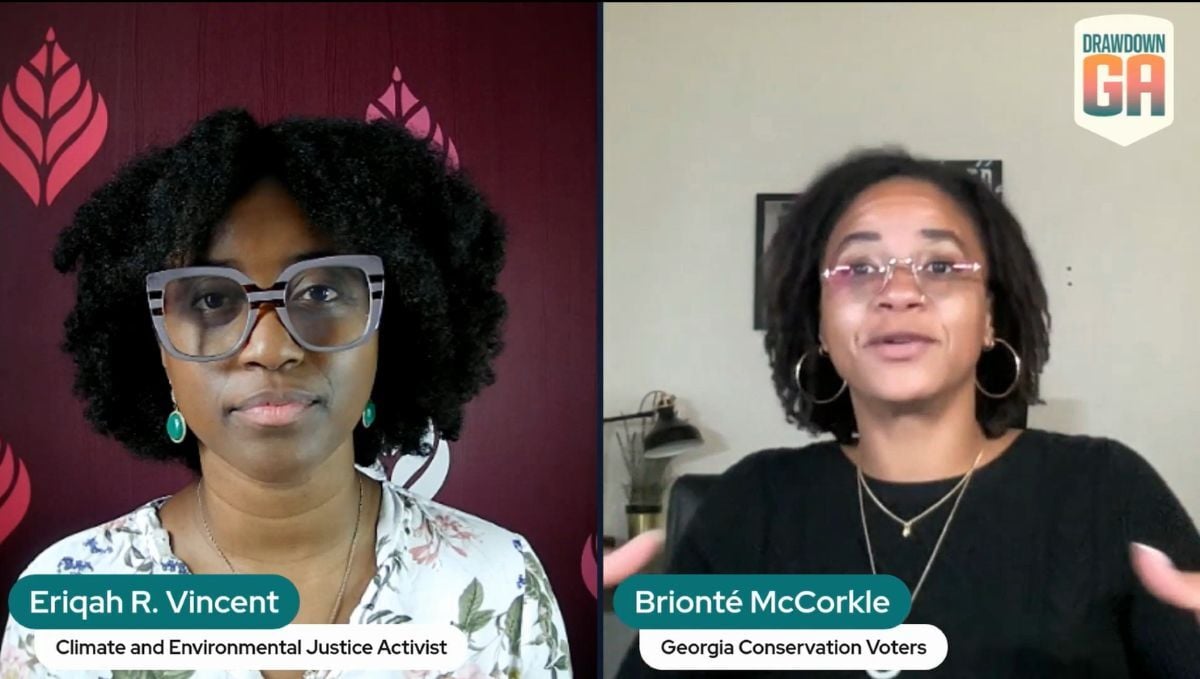How is community-led work creating climate resilience on the Georgia coast?
And what work is already being done to preserve our wetlands—a crucial climate solution in our state—and empower coastal communities?
Our Resilient Georgia Coast
To explore the answers to these questions, Drawdown Georgia co-hosted a conversation with the experts in partnership with One Hundred Miles, a conservation organization dedicated to preserving and protecting Georgia's 100-mile coast through advocacy, education, and civic engagement.
Watch the full recording below, or keep reading to learn more.
Co-moderators Megan Desrosiers and Jazz Watts of One Hundred Miles offered an overview of some of the biggest threats that coastal people, communities, and ecosystems have to overcome:
-
Development that is often sprawling, inefficient, and located in inappropriate places from a perspective of ecosystem preservation.
-
Sea level rise on the Georgia coast, which is up 8 to 10 inches compared to 80 years ago.
This webinar examined the interconnectedness of the issues impacting the Georgia coast, from ecological issues in freshwater and saltwater marshes to climate change and sea level rise to systemic inequities like racism and poverty. Jazz emphasized that disproportionate impacts underscore the need to center community-level involvement.
>> Track Georgia's progress on protecting our wetlands with the Drawdown Georgia Solutions Tracker
The Nature Conservancy: Building Coastal Resilience Through Oyster Aquaculture
Christi Lambert, Marine and Coast Conservation Director at The Nature Conservancy (TNC), mapped out the interconnectedness of Georgia’s coastal ecosystems, from rivers to reefs, and gave an overview of some of the TNC’s partnerships and projects seeking to build a more resilient Georgia coast.
Georgia’s Interconnected Watersheds
The 100 miles of Georgia's coast are home to multiple habitat types and 14 barrier island complexes. When considering the resiliency of our coastline, we must also look inland because the interconnectedness of our state’s watersheds can impact coastal areas from far away.
TNC believes that looking at issues from the broader perspective of the Georgia landscape and then zooming in to learn about them at a very local scale are equally important. For many years, The Nature Conservancy has worked with multiple stakeholders and groups throughout the coastal and inland watersheds to develop a long-term vision of a resilient network of coastal marine ecosystems, including oyster reefs, salt marshes, estuaries, and more.
Oyster Reefs as a Climate and Coastal Resiliency Solution
Did you know that oysters are a nature-based solution that could solve many of the challenges faced by coastal communities? Oysters help protect our shorelines and coastlines by providing a protective layer; they break the energy of waves to decrease erosion along the coastal areas, filter pollutants from seawater, and provide a sustainable economic resource.
To grow more oyster reefs on the coast, TNC is partnering with fishers, farmers, and researchers to develop and test different methods of growing oysters, while also learning from local knowledge and traditions around oyster farming. This inclusive process seeks to bring together living shorelines, oysters for economic opportunity, and oysters to support community traditions.
Oyster Aquaculture and Education in McIntosh County
Christi told the story of Ernest McIntosh and his family, who are fishers based out of McIntosh County and one of the first in the area to begin developing oyster aquaculture in the county.
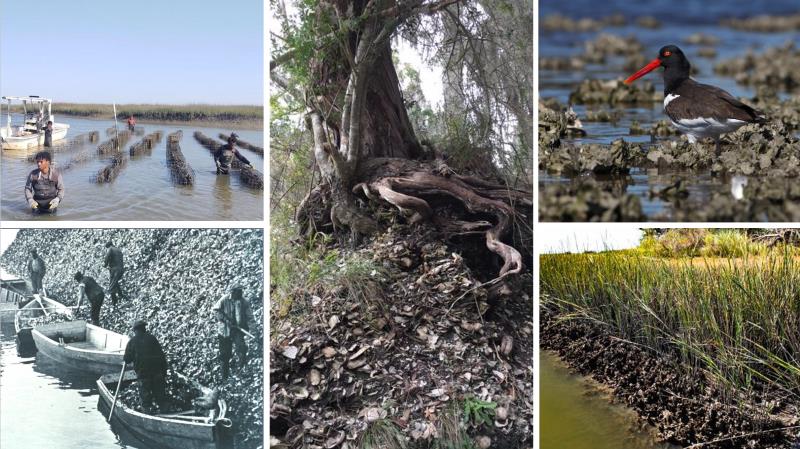
Mr. McIntosh secured a grant to engage local youth in oysters and aquaculture from The Nature Conservancy’s Supporting Oyster Aquaculture and Restoration program. This ultimately led to the development of a work-study program through McIntosh Academy to train students in aquaculture, oyster restoration ecology, and the benefits of living shorelines.
Conservation Resources from The Nature Conservancy
Christi shared useful resources developed by The Nature Conservancy that can help conservation efforts across the state and even across the country:
-
Resilient Land Mapping Tool: TNC is increasing collective impact via The Resilient and Connected Network, a proposed conservation network of representative climate-resilient sites designed to sustain biodiversity and ecological functions into the future under a changing climate; it is intended as a starting point for conversations with local communities, indigenous tribes, land trusts, agencies, corporations, and funders.
-
Georgia Coastal Resilience Map: The Coastal Resilience decision-support tool helps communities visualize risks and examine where nature can increase resilience and reduce risk through the best available science and local data on coastal hazards.
-
The Georgia Low Impact Solar Siting Tool (GA LISST): This tool provides decision-makers with the data necessary to reduce the impacts of large-scale solar energy development on sensitive natural habitats and seeks to help accelerate solar development in areas of limited environmental impacts.
-
Solar Facility Development in Georgia: This guide to best practices from the Wildlife Resources Division of the Georgia Department of Natural Resources is an additional tool to help prevent siting large-scale solar in environmentally sensitive areas.
The Coastal Equity and Resilience Hub at Georgia Tech
Jill Gambill is the Executive Director and Senior Research Associate of the Coastal Equity and Resilience Hub (CEAR) at Georgia Tech, an initiative that brings together nonprofit organizations, environmental justice organizations, local governments, and academic institutions to co-develop knowledge, tools, and approaches to building community resilience.
Defining Resilience on a Community’s Own Terms
CEAR focuses its efforts on disadvantaged communities experiencing disproportionate impacts of climate change and environmental injustices. The group strives to adopt the most holistic approach possible, to build a community’s adaptive capacity.
CEAR defines resilience as: the ability of a community to equitably prevent, withstand, respond to, and recover from a shock (such as a hurricane) or stressor (examples might be climate change or systemic inequities like racism or poverty).
Jill noted that equity is often overlooked in resilience work. If climate and resilience work focuses only on the impacts of big events like hurricanes and ignores the long-term pressures of inequalities and historic injustices simmering under the surface, the work will fail to develop true resiliency for communities.
Centering Communities in Resiliency Leadership
Jill explained that her team has found it is true that the people who are closest to the problem are closest to the solution. A researcher may have very valuable knowledge to share, but it is local knowledge and in some cases, the traditional knowledge that can be the most critical in helping to come up with solutions.
Therefore, CEAR seeks to invert the traditional path that many institutions take when working with disadvantaged communities by empowering communities to take leadership at the center of the project, while the institution provides support.
Tracking Sea Level Rise on the Georgia Coast
When the state experienced back-to-back hurricanes in 2016 and 2017, the Georgia coast faced many flooding issues. At the time only one long-term tide gauge existed on the Georgia coast, so capturing the full impact of the flooding was challenging.
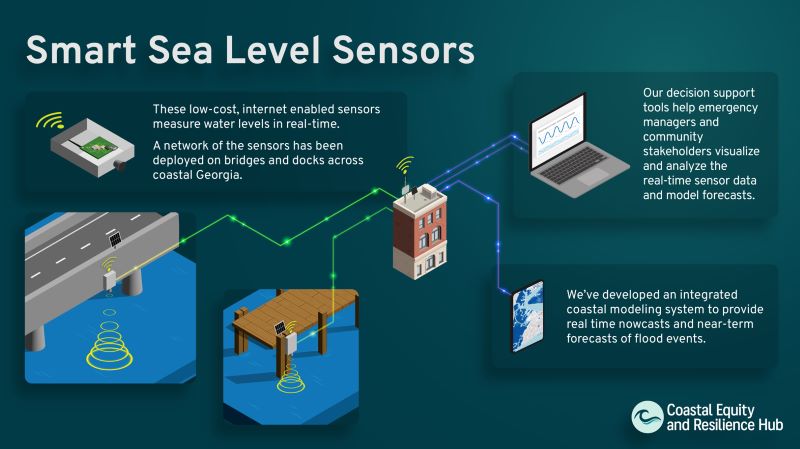
To help address this issue, Georgia Tech developed the Smart Sea Level Sensor, a low-cost device that monitors water levels in real-time, and deployed the devices throughout Chatham County. Sixty-four sensors are now being used for emergency management purposes. In addition, Georgia Tech developed a dashboard to help determine priorities for the response teams dealing with neighborhoods, roads and bridges.
Community Resilience Beyond Flood Prevention
The project began with a framework that focused on flooding, but as work began in the community, researchers heard many other concerns. In Brunswick, residents were very concerned about contamination from four nearby Superfund sites. Researchers also heard from communities about food security issues, concerns about property and land retention, and air quality issues from the ports.
This experience helped the researchers at CEAR expand their approach and inspired them to bring on additional partners with different areas of expertise to achieve a more holistic approach.
Partnerships with Gullah Geechee Communities to Build Resilience
One of the first communities that CEAR partnered with is Pin Point, a Gullah Geechee community in Chatham County, in the northern part of the Georgia coast. CEAR hosts monthly community-wide meetings and meets weekly with community leaders to surface priorities in building resilience. Climate change and its impacts are one issue; others include installing speed bumps to slow traffic, alleviating power outages caused by hurricanes, and creating hubs for emergency equipment and other resources during a natural disaster.
Additionally, CEAR is helping Pin Point to partner with the Army Corps of Engineers to learn about their flood risk and potential actions to take.
Pin Point and the Justice40 Initiative
The Justice40 Initiative is a goal set by the federal program to direct 40 percent of the overall benefits of specific climate, clean energy, affordable and sustainable housing, and other investments to historically disadvantaged communities that are marginalized by underinvestment and overburdened by pollution. The Climate and Economic Justice Screening Tool is meant to identify where these disadvantaged communities are located.
As CEAR was working with Pin Point, the team realized the community is in a census tract that is not categorized as disadvantaged, so they will not qualify for Justice40 funding. Because the community is located right on the water and a great deal of development is happening all around them that is bringing in wealthier residents, Pin Point does not qualify for this funding.
This made the team wonder if Pin Point was the only community experiencing this issue with qualifying for funding. To find out, CEAR partnered with the Pin Point Betterment Association and the Gullah Geechee Cultural Heritage Corridor Commission. Their study of 145 Gullah Geechee communities found that about half are impacted by the same problem. CEAR believes that other disadvantaged communities that are similarly surrounded by wealthier neighborhoods may face the same challenge in accessing Justice40 funding.
Emphasizing Community-Led Efforts at Harambee House
Dawud Shabaka, Associate Director and Environmental Justice Trainer at The Harambee House / Citizens for Environmental Justice, introduced Harambee House. Founded by Savannah native Dr. Mildred McClain, the inspiration for the project came from a request from the Hudson Hill community, where a radioactive spill occurred in the late 1980s.
Dr. McClain’s efforts drew attention to the disaster among a broader audience, and redress finally was made for residents of South Carolina and Savannah. That incident showed her the need for an organization like Harambee House.
Examining Different Types of Resiliency
Harambee House believes there is a twofold definition of resiliency:
-
Resiliency refers to the capacity to secure and maintain the required resources and to develop the sustainability practices needed to anticipate, respond to, and rebuild after an emergency, severe weather event, or other unanticipated disaster.
-
But it also means being able to develop and provide mechanisms to mitigate ongoing issues of legacy pollution and the daily exposure to such things as diesel particulate matter, fumes from diesel exhaust, and daily work-related toxin exposures.
This second definition is of particular importance for historically disadvantaged communities, low-income families, and many immigrant families whose jobs are more likely to expose them to chemicals and toxins on a daily basis. Due to redlining and other racist housing practices, many of those communities find that the only housing available to them is near ports or industrial areas where air and water pollution is more common.
Harambee House has found that the individuals who are constantly exposed to these hazardous conditions are the best-suited to finding appropriate solutions: they are the subject matter experts. This is why Dawud and his team agreed to join CEAR in their work in Pin Point: both organizations recognized the importance of consulting with the individuals most impacted by the issues first.
Principles of Environmental Justice and Resiliency
Another way to view resiliency is that it means following the 17 Principles of Environmental Justice adopted by the First National People of Color Environmental Leadership Summit held in Washington, D.C., in 1991.
The 17 Principles emphasize the importance of working from the bottom up to create change and build resiliency. Beginning the process with the front-line communities can help develop a base of more effective, practical, real-world solutions to everything from sea level rise to unjust energy burdens.
Takeaways from Building Climate Resilience on the Georgia Coast to Develop Community-Led Solutions
If you are involved in work that seeks to build resiliency, alleviate injustices, lift up historically disadvantaged communities, and scale climate solutions with an emphasis on equity, these are the lessons from our panelists based on their experience building a resilient Georgia coast:
-
Climate change is complex and its impacts touch on so many different aspects of our lives and the world around us. That’s why the best way to move forward is through collaboration. Each organization working on the Georgia Coast has a little piece of the solution. It takes time to get to know each other and discover where one group’s knowledge can build on another’s. It’s scary when you see how fast things are changing, but it is the most effective and inclusive path.
-
Sharing power is essential for building trust and creating partnerships. Think about who has the power in each space and community, and whether or not they are sharing it. Ask, what are you doing with your power and the space you occupy?
-
Consider what you can do differently in your work. Remember that we are all still learning and have much to learn from each other.
Connect with the Drawdown Georgia Climate Community
Don’t miss out on future webinars and events from Drawdown Georgia! Click the button below to subscribe to the Georgia Climate Digest and receive climate news and event updates in your inbox twice per month.


